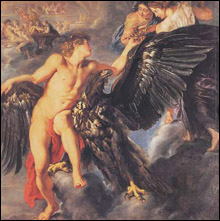Most theologians would argue that the relationship between John and Jesus was platonic, and they’d be right — but in the wrong sense of the word. Brown, it turns out, gets at least one thing right when he says, “When Christianity came along, the old pagan religions did not die easily.” While contextually, the images of Jesus and St. John are Christian, the iconography itself is much older. The pairing of Jesus and his young partner in medieval and Renaissance art is frequently reminiscent of images of Zeus and Ganymede. In Greek mythology, Zeus, in the form of an eagle, abducted the young Trojan prince to make him his cupbearer on Mount Olympus, and thus they became the most famous same-sex couple in the ancient world. The highly erotic Zeus-Ganymede myth was so commonplace that art historian James Saslow notes in his groundbreaking 1986 study Ganymede in the Renaissance (Yale) that there are well more than 200 versions of it in the Renaissance and early Baroque periods. The associations between Zeus-Ganymede and Jesus-John were so strong that in Christian iconography the official emblems of St. John were the eagle and the chalice. Of course, the difference is that the Zeus-Ganymede story is explicitly gay and the Jesus-John story is not.
|

DIVINE COUPLINGS: Medieval and Renaissance renderings of Jesus and St. John recall the homoerotic imagery of pagan Greek mythology, notably the joining of Zeus (in the form of an eagle) and the youth Ganymede — here portrayed in a 1611 painting by Reubens.
|
Perils of history
One of the reasons The Da Vinci Code is so popular is that a large number of readers deeply question patriarchal Christianity. Dan Brown’s novel is a compelling fantasia on Christian history in which sexuality and gender take on radically different meanings and realities. The Vatican and other Christian denominations hate Brown’s novel and have been campaigning against Ron Howard’s film because they understand that, despite the ludicrousness of Brown’s narrative, its main thrust is truthful: Christianity has been appallingly, murderously misogynist. But there is no need for conspiracy theories to grasp this obvious historical truth. The same is true of mainstream Christianity’s treatment of lesbian and gay men. Its campaigns against gay equality under the law, same-sex marriage, and gay adoption have been vicious in the extreme.
It would be a mistake, however, to demand that Christianity should be loving and supportive of homosexual women and men just because there is a long, hidden history of their inclusion in the church, or because past artists and even evangelists presented Jesus as a lover of men. Readers of The Da Vinci Code — enthusiasts and revilers alike — should bear at least one thing in mind: using “history” to justify moral decency is always a mistake because moral decency requires no justification.
Michael Bronski is the author of Pulp Friction: Uncovering the Golden Age of Gay Male Pulps (St. Martin’s Press, 2003)
Email the author
Michael Bronski: mabronski@aol.com
ADVERTISEMENT
 |